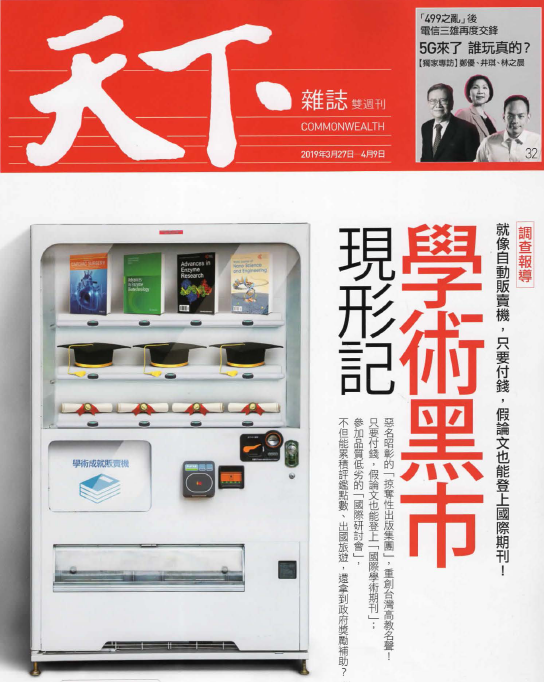掠奪性期刊風暴來襲,相關研究與報導一次看
本文最近更新日期:2024年10月21日
掠奪性期刊風暴來襲,不管是有心操作,還是無辜上當,對學界而言都是一項需審慎檢視的議題。國內外做過哪些相關研究?簡易的查證管道有哪些?本文將重點式聚集相關網站與文章,供讀者查閱。
《天下雜誌》第669期的一系列報導:
- 盧沛樺、田孟心、楊卓翰、陳一姍(2019年3月)。台灣為何成為掠奪性期刊的大肥羊?學術黑市現形記。天下雜誌,669期,85-95。
- 楊卓翰(2019年3月)。日本學者痛批:學術騙徒正傷害台灣名聲。天下雜誌,669期, 96-99。
- 楊卓翰(2019年3月)。台灣掠奪性集團操盤手:一開始,我們真的有偉大理想。天下雜誌,669期,100-107。
- 田孟心(2019年3月)。送上門來的邀稿信,小心你的論文被綁架。天下雜誌,669期,116。
※ 圖書館的紙本雜誌請點此查看、電子版請點此查看(HTML純文字、PDF圖文版,最新一期會延遲上線)。
相關新聞追蹤報導:
- 何定照(2019年3月27日)。黃國昌:掠奪性期刊 台大、南榮科大各20篇居冠 (2024/10/16更新:原始新聞連結已失效)。聯合新聞網。取自:https://udn.com。
- 楊綿傑(2019年3月27日)。國內百所大學陷「掠奪性期刊」學術風暴 科技部將進行調查。自由時報電子報。取自:https://www.ltn.com.tw/。
- 劉麗榮(2019年3月27日)。教授疑涉掠奪性期刊會議 科技部3個月內追查。中央通訊社。取自:https://www.cna.com.tw/。
- 李侑珊(2019年3月27日)。立委控「掠奪性期刊」讓學術蒙羞 科技部3個月內說明。中時電子報。取自:https://www.chinatimes.com。
- 聯合新聞網(2024年3月27日)。國際研討會竟是假!台生繳費後求證飯店才知被騙 台大教授也遭冒名。聯合新聞網。取自:https://udn.com。
※ 電子新聞並非永久連結,若想持續追蹤「掠奪性期刊」的相關報導,請進入本館報紙資料庫查詢:中央通訊社中英文新聞資料庫 、台灣新聞智慧網、知識贏家、聯合知識庫。
期刊文章:以下文章為列舉,如欲查詢更多及更新文章,敬請使用相關資料庫查詢。
臺灣學者探討「掠奪性期刊」議題的文章,以下文章可於華藝線上圖書館取得全文:
- 林奇秀、 賴璟毅(2014)。開放近用的陰暗面: 掠奪型出版商及其問題。圖書與資訊學刊, 6(2),1-21。
- 辜美安、賴金英(2016)。學術著作投稿的陷阱:掠奪型期刊。臺灣醫學,20(2),216-221。
- 彭台光(2018)。商管領域掠奪型出版:學術期刊黑名單與白名單及因應建議。管理學報,35(2),241-266。
- Lin, C.-S. (2017). An Exploratory Survey of the Suspicious Open Access Journals. Journal of Library and Information Studies, 15(2), 45-66.
中國大陸探討「掠奪性期刊」議題的文章,以下文章可於 CNKI資料庫取得全文:
- 郭進京、陳秀娟、陳雪飛、黃金霞(2015)。劫持性期刊現象研究。圖書與情報,2015(5),16-24。
- 江曉原、穆蘊秋(2017)。警惕國外“開放存取雜誌”及“掠奪性期刊”的陷阱。出版發行研究,2017(8),70-71。
- 陳銘(2018)。圖書館情報學領域的掠奪性期刊研究。圖書館論壇,2018(1),56-61。
- 楊克魁、姚亞楠(2014)。由掠奪性期刊引發的反思。科技傳播,2017(13),13-14。
- 陳銳鋒(2013)。防治學術病,促使科技期刊健康發展。科技與出版,2013(8),113-117。
為了客觀界定「掠奪性期刊」,中國大陸有學者發展出指標「期刊JPI指數」,用來判斷是否為掠奪性期刊。
- 王凌峰、杜艷玲、唐碧群(2018)。國內”掠奪性期刊”量化定義:期刊JPI指數。晉圖學刊,166(3),5-9。
國外探討「掠奪性期刊」議題的文章,以下文章可於 LISA 資料庫或圖書館SLIM系統的整合查詢功能取得全文:
- Ayeni, P. O., & Adetoro, N. (2017). Growth of predatory open access journals: Implication for quality assurance in library and information science research. Library Hi Tech News, 34(1), 17-22. doi:http://dx.doi.org/10.1108/LHTN-10-2016-0046
- Beall, J. (2012). Predatory publishers are corrupting open access. Nature, 489(7415), 179. doi: 10.1038/489179a
- Berger, M., & Cirasella, J. (2015). Beyond Beall’s list: Better understanding predatory publishers. College & Research Libraries News, 76(3), 132-135. doi: 10.5860/crln.76.3.9277
- Bowman, J.D. (2014). Predatory publishing, questionable peer review, and fraudulent conferences. The American Journal of Pharmaceutical Education, 78(176). doi: 10.5688/ajpe7810176
- Butler, D. (2013). Investigating journals: The dark side of publishing. Nature, 495(7422), 433-435. doi: 10.1038/495433a
- Erfanmanesh, M., & Pourhossein, R. (2017). Publishing in predatory open access journals: A case of Iran. Publishing Research Quarterly, 33(4), 433-444. doi:http://dx.doi.org/10.1007/s12109-017-9547-y
- Hemmat Esfe M, Wongwises S, Asadi A, et al. (2015). Fake journals: their features and some viable ways to distinguishing them. Science and Engineering Ethics, 21(821-4). doi: 10.1007/s11948-014-9595-z
- Lang, R., Mintz, M., Krentz, H. B., & Gill, M. J. (2019). An approach to conference selection and evaluation: Advice to avoid “predatory” conferences.
Scientometrics, 118(2), 687-698. doi:http://dx.doi.org/10.1007/s11192-018-2981-6 - Perlin, M. S., Imasato, T., & Borenstein, D. (2018). Is predatory publishing a real threat? evidence from a large database study. Scientometrics, 116(1), 255-273. doi:http://dx.doi.org/10.1007/s11192-018-2750-6
- Ross-White, A., Godfrey, C. M., Sears, K. A., & Wilson, R. (2019). Predatory publications in evidence syntheses. Journal of the Medical Library Association, 107(1), 57-61. doi:http://dx.doi.org/10.5195/jmla.2019.491
- Shen, C., & Björk, B. (2015). ‘Predatory’ open access: A longitudinal study of article volumes and market characteristics. BMC Medicine, 13(230). doi: 10.1186/s12916-015-0469-2
- Smith, K. L. (2017). Examining publishing practices: Moving beyond the idea of predatory open access. Insights, 30(3), 4-10. Retrieved from https://search.proquest.com/docview/1967317009?accountid=14229
- Stratford, M. (2012). ‘Predatory’ online journals lure scholars who are eager to publish. Chronicle of Higher Education, 27, A1-A8.
- Taylor, Z. W. (2019). The hunter became the hunted: A graduate Student’s experiences with predatory publishing. Publishing Research Quarterly, 35(1), 122-137. doi:http://dx.doi.org/10.1007/s12109-019-09639-7
- Xia, J. (2015). Predatory journals and their article publishing charges. Learned Publishing, 28(1), 69-74. doi: 10.1087/20150111
- Xia, J., Harmon, J., Connolly, K., Donnelly, R., Anderson, M., & Howard, H. (2015). Who publishes in predatory journals. Journal of the Association for Information Science and Technology, 66(7), 1406-1417. doi: 10.1002/asi.23265

1. Beall’s List
Beall’s List揭露了可能為掠奪性期刊的清單。若網站無法連結成功,可先點此查看過往清單。(2017/12更新)
2. DOAJ
透過DOAJ可查證是否為Open Access期刊,同時該資料庫的收錄原則亦考量同儕審查(peer review)機制,收錄內容普遍認知是較具公信力的。
Research Gate是學界的社群網站,研究人員在此交流分享資訊,依據同領域學者的經驗分享,經常能在此得到可疑出版社或研討會的相關訊息。
4. 分辨流程(辜美安、賴金英,2016)
出版社普遍秉持期刊需要高規格的同儕審查機制,以確保文章的品質,主張必須彰顯「文章影響力」數據。但不同出版社可能又有相異的評估方式。
正由於評估的準則各執一詞,也有人質疑 Beall’s List,認為Beall的觀點存有偏見,尤其針對較新的期刊或是開發中國家的期刊,提出這樣的觀點會令Open Access期刊的處境更雪上加霜。不同立場的思維,也提供大家思考。
- Beyond Beall’s List: Better understanding predatory publishers
- Predatory Publishers | Peer to Peer Review

請參考:教育部臺灣學術倫理教育資源中心之「留意掠奪性期刊及會議」議題教材包、中央研究院之「學術倫理─掠奪性期刊與會議」專區。
【延伸閱讀】
- 慎防「學術詐騙」停!看!聽!
- 慎選學術會議/研討會
- 「掠奪性期刊」實際案例破解【1】【2】【3圖書】【4研討會】【5收錄EI】【6線上研討會】
作者:學科服務組
本文更新歷程:2019/5/10、2024/3/29、2024/10/16、2024/10/21



